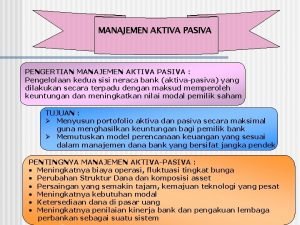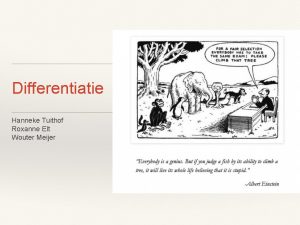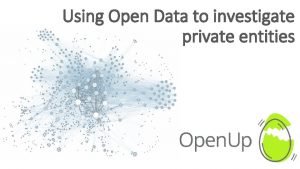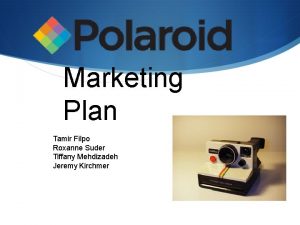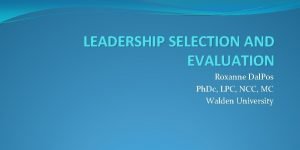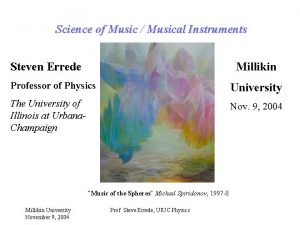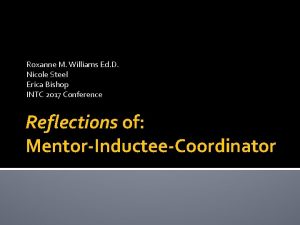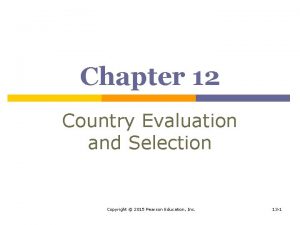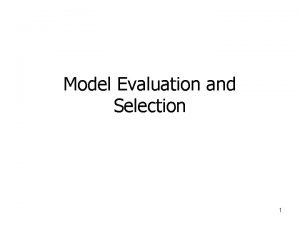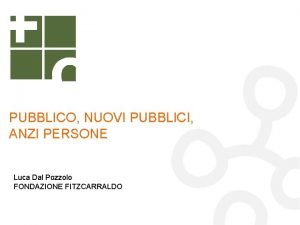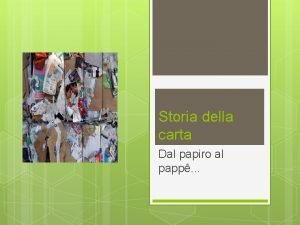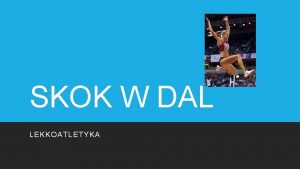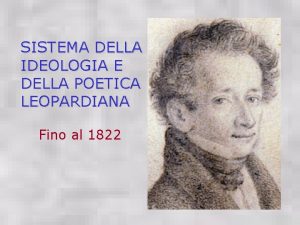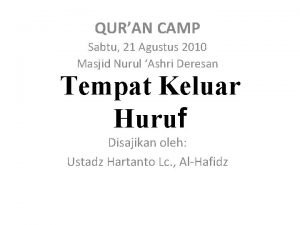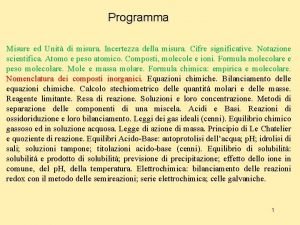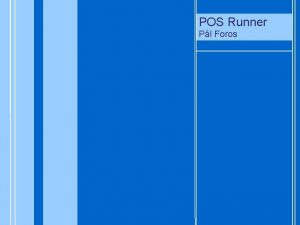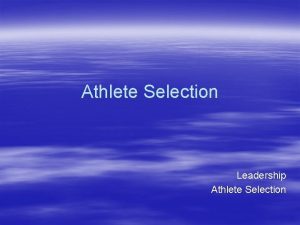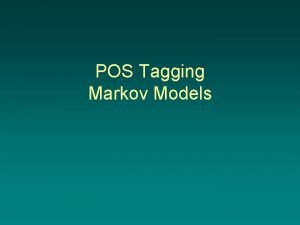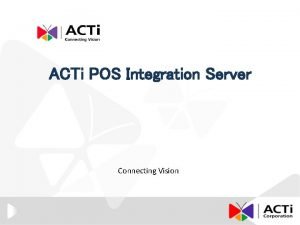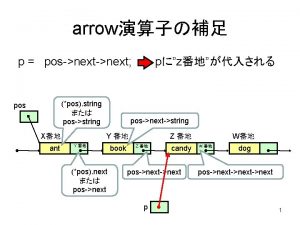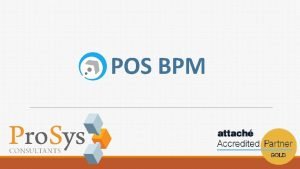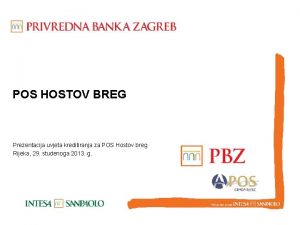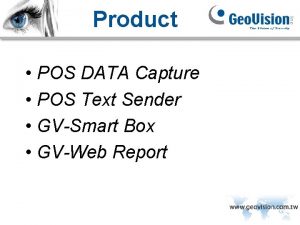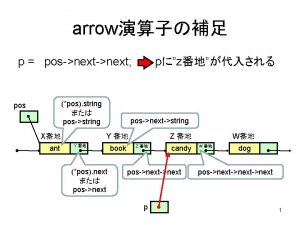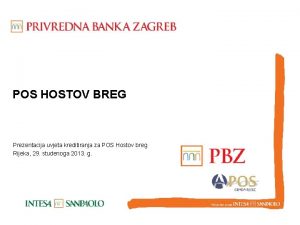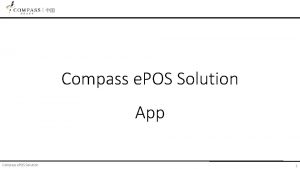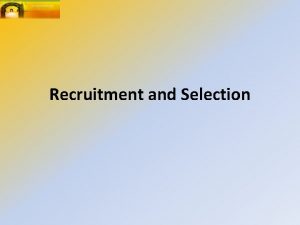LEADERSHIP SELECTION AND EVALUATION Roxanne Dal Pos Ph


































- Slides: 34

LEADERSHIP SELECTION AND EVALUATION Roxanne Dal. Pos Ph. Dc, LPC, NCC, MC Walden University

Segment One �Simplification Heuristics � Tenuous selection process � Route of least resistance � Status Quo

PROTOTYPES • Recognition bias • Matching/Mismatching • Ethical dangers

VALUE �Rebuild infrastructure �Globalization �Recession �Unstable market �Organizational Climate �Performance & Productivity

CONTINGENCY THEORY �Situational influence �Additive value of gender/race/ethnicity differences �Objective evaluations

BREAK �Completion of DAP �Confidentiality �Awareness purpose DAP

SEGMENT 2 HISTORY Trait Approach � Assumptions � “Extraordinary abilities” � Special endowment-heroic � Based on who already was a leader � Not validated in research � Feeds our desire to simplify � Heuristic is not a conscious thought process � Awareness does not imply deselecting the “norm”

VALUE OF DIFFERENCES Male �Task oriented Blacks & Hispanics • Giving support • Contagious Enthusiasm • Removing roadblocks Middle East & Native American • Collaborative • Foster group goals • Interdependency • Group harmony Female �Relationship oriented Eastern Indians/Asians • Value learning & knowledge • High Scientific Education • Eastern Indians similar to White Americans • Warmth & competence • Competition • Plus Expressiveness & Family orientation equal for men and women

“If leaders are to be effective in a diverse society, they need to understand their own preferred style and behaviors and how these may differ from those preferred by others. Otherwise, their interactions with others are likely to be fraught with misattributions, misunderstandings, and misinterpretations” (Ayman, Korabik, 2010, p. 157).

Multicultural perspective �Eliminate Ethnocentrism �Increase isomorphic attributions �Own cultural values do not have to be the same as all others �Ability for diverse groups to reach similar assessment of situation �Less hostile judgments �More cohesive operations

BREAK

SEGMENT 3 EFFECTIVE & DERAILED LEADERS REMEMBER • Arthur Andersen • Tyco • World. Com • Enron • Adelphia • Fannie Mae • Rite Aid • Phar-Mor

BEING IN A LEADERSHIP POSITION DOES NOT IMPLY BEING EFFECTIVE HENCE, THE OLD THEORIES THAT EXAMINED THOSE WHO WERE ALREADY LEADERS DOES NOT IMPLY EFFECTIVE LEADERS And, those from groups who are not well represented in leader roles are not automatically ineffective

RISE • Prior role success • Performance in verbal communications

FAL L �Strengths become weakness �Trait in extreme a weakness �Confidence to arrogance �Innovation to reclessness �Decisiveness to rashness �Integrity to fanaticism �Vision to lack of focus

EFFECTIVE LEADERS �“create a spirit of performance by doing the right thing and getting the right things done” (Maciariello, 2007, p. 20) � INTEGRITY � VISION FOR THE PURPOSE �“the pattern of high intelligence, dominance, GSE (general self efficacy), and self-monitoring showed consistency in the prediction of both emergence and effectiveness criteria” (Foti & Hauenstein, 2007, p. 353) • Organizational culture

DERAILED LEADERS �Versatility �Selection process �Organization dynamics �Individual inadequacies �Success trap �Low pressure tolerance �Blame �Over ambitious �Change in critical skills �Insensitivity, abrasiveness and intimidation

If we take a look into the past as a reflection of current employment laws we can see that many laws and unions came about as a response to insensitivity, abrasiveness, and intimidation in the workplace so how can the antiquated model of leadership be effective if the leaders needed protected from themselves?

FAST TRACKING Road to derailment Robs learning Lack of interdependence requirement

ORGANIZATIONAL CULTURE AND SITUATIONAL VARIABLES Economics Politics Low compatibility with organization

CHARISMA �Remember Hitler, Stalin �Easy rise but low wisdom �Problems too complex for the great orators

Sternberg (2005) identifies thinking fallacies that derail leaders lacking in wisdom: The first, the unrealistic-optimism fallacy, occurs when they think they are so smart and effective that they can do whatever they want. The second, the egocentrism fallacy, occurs when successful leaders start to think that they are the only ones that matter, not the people who rely on them for leadership. The third, the omniscience fallacy, occurs when leaders think that they know everything and lose sight of the limitations of their own knowledge. The fourth, the omnipotence fallacy, occurs when leaders think that they are all-powerful and can do whatever they want. The fifth, the invulnerability fallacy, occurs when leaders think that they can get away with anything because they are too clever to be caught and, even if they are caught, that they can get away with what they have done because of who they imagine themselves to be. The sixth, the moral disengagement fallacy, occurs when a leader ceases to view his or her leadership in moral terms but rather only in terms of what is expedient.

REMEMBER ENRON, TYCO, WORLDCOM, ARTHUR ANDERSEN….

BREAK

SEGMENT 4 MODERN CONTINGENCY THEORIES • Leadership is a process, not a property of a person. • The process involves a particular form of influence called motivating. • The nature of the incentives, extrinsic or intrinsic, is not part of the definition. • The consequence of the influence is collaboration in pursuit of a common goal. • The “great things” are in the minds of both leader and followers and are not necessarily viewed as desirable by all other parties. Vroom & Jago (2007)

SITUATIONAL VARIABLES • the quality of the leader–subordinate relationship, • the structure of the task, and • the position power of the leader. (Ayman, 2002)

WICS effective leadership is a synthesis of wisdom, creativity, and intelligence. Creativity refers to the skills and dispositions needed for generating ideas and products that are (a) relatively novel, (b) high in quality, and (c) appropriate for the task at hand (Sternberg & Lubart, 1995). (Sternberg, 2005) Successful intelligence is defined as “the skills and dispositions needed to succeed in life, given one's own conception of success, within one's sociocultural environment” (Sternberg, 2005, p. 34). Is there anything in a given name or heritage that implies intelligence? Practical intelligence is a part of successful intelligence. Practical intelligence is the set of skills and dispositions used to solve everyday problems by applying knowledge gained from experience to purposefully adapt to, shape, and select environments. It thus involves changing oneself to suit the environment (adaptation), changing the environment to suit oneself (shaping), or finding a new environment within which to work (selection). One uses these skills to (a) manage oneself, (b) manage others, and (c) manage tasks. (Sternberg, 2005)

WISDOM Wisdom is in large part a decision to use one's intelligence, creativity, and knowledge for a common good. Thus, wisdom involves not only skills in the use of these elements but also the disposition to use them for the common good. (Sternberg, 2005) • rich factual knowledge (general and specific knowledge about the conditions of life and its variations), • rich procedural knowledge (general and specific knowledge about strategies of judgment and advice concerning matters of life), • life span contextualism (knowledge about the contexts of life and their temporal [developmental] relationships), • relativism (knowledge about differences in values, goals, and priorities), and • uncertainty (knowledge about the relative indeterminacy and unpredictability of life and ways to manage). Sternberg, (2005)

SYNTHESIS

BREAK

SEGMENT 5 IMPROVED DECISION MAKING • Emotional stability and maturity • Personal integrity • Socialized power motivation • Moderately high achievement orientation • Low need for affiliation • Internal locus of control • Self confidence

PLUS • Intuition • Some “smarts” • Interpersonal skills • Emotional intelligence • Social intelligence • Systems thinking • Ability to learn

LEADERSHIP STYLES • Taskmaster • Comforter • Regulator • Manipulator

CLOSING • Handouts • Exit profile • Use into the future Be objective, look for behaviors that are represented by potential and existing leaders that point to a wise use of intelligence, sensible risk taking, and skills that bring together the organization as people, provide strong performance, and present authentic integrity in all business dealings. THANK YOU!!!!
 Adulteration of dal with kesari dal mainly causes
Adulteration of dal with kesari dal mainly causes Manajemen aktiva dan pasiva
Manajemen aktiva dan pasiva Roxanne borja sex
Roxanne borja sex Roxanne rodgers
Roxanne rodgers Roxanne elt
Roxanne elt Windeeds
Windeeds Tiffany mehdizadeh
Tiffany mehdizadeh Roxanne dalpos
Roxanne dalpos Roxanne
Roxanne Cochlear
Cochlear Roxanne evertson
Roxanne evertson Roxanne grant
Roxanne grant Country evaluation and selection
Country evaluation and selection Model evaluation and selection
Model evaluation and selection Two way selection and multiway selection in c
Two way selection and multiway selection in c Multiway selection
Multiway selection Mass selection and pure line selection
Mass selection and pure line selection Transactional vs transformational leadership
Transactional vs transformational leadership Source selection plan
Source selection plan Balancing selection vs stabilizing selection
Balancing selection vs stabilizing selection Similarities
Similarities K selection r selection
K selection r selection Natural selection vs artificial selection
Natural selection vs artificial selection Difference between continuous and discontinuous variation
Difference between continuous and discontinuous variation What is artificial selection
What is artificial selection K selection r selection
K selection r selection Natural selection vs artificial selection
Natural selection vs artificial selection Adaptive leadership theory
Adaptive leadership theory Capable but cautious performer
Capable but cautious performer Luca dal pozzolo
Luca dal pozzolo Dal papiro alla carta
Dal papiro alla carta Technika naturalna skoku w dal
Technika naturalna skoku w dal Conversione dall'erudizione al bello
Conversione dall'erudizione al bello Makhraj huruf dal
Makhraj huruf dal Acido fosoforoso
Acido fosoforoso

